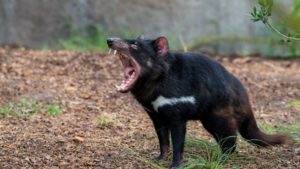In the golden age of cartoons, the Tasmanian Devil was a favorite Looney Toons character, a whirling tornado throwing temper tantrums, and eating everything in his path. Both Bugs Bunny and Daffy Duck had to cleverly escape his voracious appetite. It has been 54 years since Warner Brothers discontinued the cartoons, yet that character inspired generations to worry about the fate of the real devils, native only to Tasmania and nearby islands.
 Real Tasmanian devils are nothing like an adorable cartoon character. The carnivorous marsupial is anything but cute, looking like a small black dog with an oversized head and nasty teeth, is so antisocial it cannot be domesticated, is notoriously ill-tempered, and has a mean case of body odor. They have been decimated by a horrible facial tumor disease that wiped out 80 percent of them. Together with hunting (aborigines collected their teeth for necklaces, and European settlers killed them to protect livestock), the disease nearly sent the species the way of the dodo.
Real Tasmanian devils are nothing like an adorable cartoon character. The carnivorous marsupial is anything but cute, looking like a small black dog with an oversized head and nasty teeth, is so antisocial it cannot be domesticated, is notoriously ill-tempered, and has a mean case of body odor. They have been decimated by a horrible facial tumor disease that wiped out 80 percent of them. Together with hunting (aborigines collected their teeth for necklaces, and European settlers killed them to protect livestock), the disease nearly sent the species the way of the dodo.
Today the little devils are among conservation’s great success stories. A sanctuary program that provided large quarantine facilities, where the animals could multiply and thrive free from the disease, has now closed its doors – not because of funding, but because the program succeeded. A species previously listed as endangered has now been declared recovered. Healthy animals are now being inoculated against the disease, reintroduced to the wild, and flourishing. The Menzies Institute, with several other university and non-profit partners, reintroduced over 125 animals on several parts of the island, helping immunize the existing populations, increasing genetic diversity, and generally making the people of Australia proud. We should all be proud. There are once again thousands of the little devils whirling around their island.
We ought to boast of similar successes in America, where we have listed nearly 2,000 species as threatened and endangered over the past 45 years – except we have recovered almost none.
The difference is that in the U.S., when a species is declared endangered, it triggers a punitive regulatory regime that dictates what people can and cannot do on their property, and imposes stiff penalties for disturbing habitat, even in the course of ordinary work like farming. The result is a distrust between private landowners (who own most endangered species habitat and whose cooperation is therefore essential) and federal regulators. That creates backwards incentives, so instead of helping species survive, many landowners are afraid even to acknowledge them.
It is generally illegal in this country to possess endangered species, much less raise them in captivity for reintroduction. States occasionally do so, however, and in Colorado we did a great deal of that, often despite federal opposition. I’m proud of the reintroduction and recovery of a number of species by Colorado’s Wildlife team, especially the lynx, black-footed ferrets, river otters, moose, desert bighorns, greater prairie chickens, boreal toads, and several endangered fish.
A primary problem with our regulatory system is that it refuses to define success. We do not have clear recovery goals for most listed species, so there is no criteria for de-listing. How will we know when a species is recovered? Our system places zero priority on such pesky details, which explains why only one percent of all listed species have ever been de-listed. We have talked about this problem for years, and the message has finally begun to penetrate the federal system. Embarrassed by the inescapable conclusion that the Endangered Species Act is a dismal failure, the government finally began a couple years ago to take a few species off the list.
At the time, the number of species declared “recovered” was only ten; today it is 40. That may not demonstrate a new commitment to species recovery, but at least a recognition that continued public support requires showing some success. A new study by one of the top experts in this field, Heritage Foundation’s Rob Gordon, found that the actual number “recovered” is probably only about 20. The others should never have been listed; they were counted incorrectly, or not at all in many cases. The original listing data was wrong.
In truth, nearly every recovered species owes its survival to state and local projects, in cooperation with private landowners – not to any federal program. Our process should incentivize such recovery projects, and discontinue the failing punitive approach. That means trusting ordinary people to care about the wildlife in their area, and even encouraging non-government projects like that in Tasmania. For the federal government, that’s a devil of a dilemma.
A version of this column originally appeared in the Grand Junction Daily Sentinel May 18, 2018.





Comments on this entry are closed.